Small overlap front: driver-side
Rating applies to 2014-15 models built after November 2013
Tested vehicle: 2014 Toyota Prius Two 4-door
The Toyota Prius was redesigned for the 2010 model year. As in earlier models, the Prius is a hybrid with both a gasoline engine and electric motor. A Prius Plug-in model was introduced in the 2012 model year. This variant also uses a gasoline engine and electric motor, but the motor's lithium-ion battery can be charged by connecting it with an electrical cord to a standard household outlet. The Plug-in is designed to operate primarily in electric mode for 11 miles from a full charge. Beyond this range, it operates in the same manner as the standard Prius.
Beginning with 2014 Prius and Prius Plug-in models, the front structure was modified and the side curtain airbags were lengthened to improve occupant protection in small overlap frontal crashes. Then, starting with 2014 cars built after November 2013, the 15-inch alloy wheels standard on most models were sourced from a single supplier to provide a more controlled crush during the small overlap test. (Information about when a specific vehicle was manufactured is on the certification label typically affixed to the car on the driver door or adjacent B-pillar.)
| Overall evaluation | |
|---|---|
| Structure and safety cage | |
| Driver injury measures | |
| Head/neck | |
| Chest | |
| Hip/thigh | |
| Lower leg/foot | |
| Driver restraints and dummy kinematics The dummy’s head barely contacted the frontal airbag before sliding off the left side, leaving the head vulnerable to contact with forward structure. Additionally, the seat belt allowed excessive forward excursion of the dummy’s head and torso. The side curtain airbag deployed and had sufficient forward coverage to protect the head from contact with side structure and outside objects. |

Action shot taken during the small overlap frontal crash test.
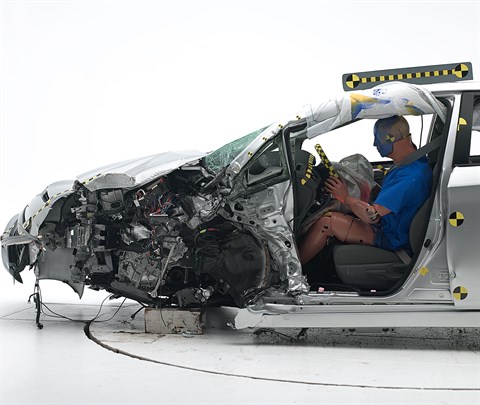
The dummy's position in relation to the door frame, steering wheel, and instrument panel after the crash test indicates that the driver's survival space was not maintained well.
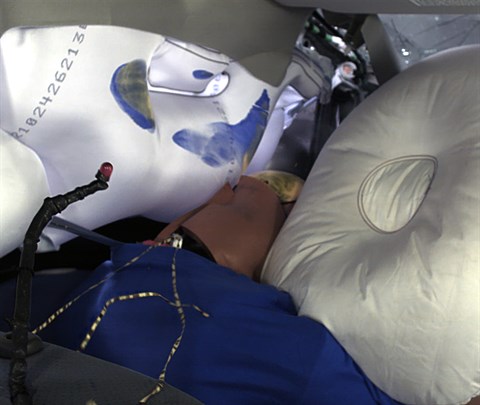
During the crash, the dummy's head barely contacted the frontal airbag before sliding off to the left, and the seat belt allowed the dummy to move too far forward, as is evident from the gap between the dummy's torso and the seat back.

Despite considerable intrusion of the door hinge pillar, parking brake pedal (see arrow), and instrument panel, risk of injuries to the dummy's legs and feet was low.
Measures of occupant compartment intrusion on driver side
| Test ID | CEN1347 |
|---|---|
| Lower occupant compartment | |
| Lower hinge pillar max (cm) | 22 |
| Footrest (cm) | 7 |
| Left toepan (cm) | 2 |
| Brake pedal (cm) | 5 |
| Parking brake (cm) | 19 |
| Rocker panel lateral average (cm) | 1 |
| Upper occupant compartment | |
| Steering column | 0 |
| Upper hinge pillar max (cm) | 13 |
| Upper dash (cm) | 14 |
| Lower instrument panel (cm) | 17 |
Driver injury measures
| Test ID | CEN1347 |
|---|---|
| Head | |
| HIC-15 | 170 |
| Peak gs at hard contact | no contact |
| Neck | |
| Tension (kN) | 1.5 |
| Extension bending moment (Nm) | 10 |
| Maximum Nij | 0.29 |
| Chest maximum compression (mm) | 20 |
| Femur (kN) | |
| Left | 2.9 |
| Right | 0.3 |
| Knee displacement (mm) | |
| Left | 7 |
| Right | 0 |
| Knee-thigh-hip injury risk (%) | |
| Left | 0 |
| Right | 0 |
| Maximum tibia index | |
| Left | 0.52 |
| Right | 0.28 |
| Tibia axial force (kN) | |
| Left | 1.7 |
| Right | 1.3 |
| Foot acceleration (g) | |
| Left | 43 |
| Right | 85 |
Moderate overlap front: original test
Rating applies to 2010-15 models
Tested vehicle: 2010 Toyota Prius 4-door
The Toyota Prius was redesigned for the 2010 model year. As in earlier models, the Prius is a hybrid with both a gasoline engine and electric motor. A Prius Plug-in model was introduced in the 2012 model year. This variant also uses a gasoline engine and electric motor, but the motor's lithium-ion battery can be charged by connecting it with an electrical cord to a standard household outlet. The Plug-in is designed to operate primarily in electric mode for 11 miles from a full charge. Beyond this range, it operates in the same manner as the standard Prius.
Two tests of the Prius were conducted, the first by Toyota of a 2010 Prius as part of frontal crash test verification and the second by the Institute of a 2012 Prius Plug-in. Ratings are based on both tests and apply to both Prius variants. Vehicle specifications are provided for the 2010 Prius from the Toyota test and photos are provided from the Institute's test of the 2012 Prius Plug-in.
| Overall evaluation | |
|---|---|
| Structure and safety cage | |
| Driver injury measures | |
| Head/neck | |
| Chest | |
| Leg/foot, left | |
| Leg/foot, right | |
| Driver restraints and dummy kinematics |
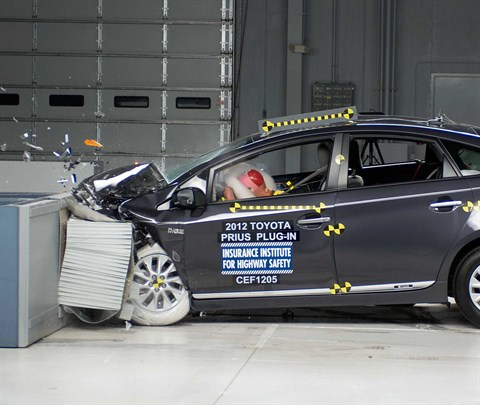
Action shot taken during the Institute's moderate offset frontal crash test.
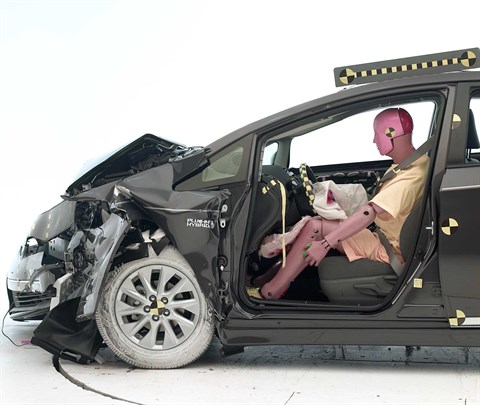
The dummy's position in relation to the steering wheel and instrument panel after the crash test indicates that the driver's survival space was maintained very well (Institute test car shown).

Dummy movement was well controlled in both tests. During rebound in the Institute's test, the dummy's head hit the roof rail, as indicated by smeared greasepaint.

In both tests, intrusion into the driver's space was minimal, and all leg and foot injury measures were low (the yellow strip is marking tape that came off the instrument panel during the Institute's test).
Measures of occupant compartment intrusion on driver side
| Test ID | VTF0901 | CEF1205 |
|---|---|---|
| Footwell intrusion | ||
| Footrest (cm) | 2 | 6 |
| Left (cm) | 8 | 9 |
| Center (cm) | 12 | 17 |
| Right (cm) | 4 | 9 |
| Brake pedal (cm) | 3 | 6 |
| Instrument panel rearward movement | ||
| Left (cm) | 3 | 4 |
| Right (cm) | 3 | 3 |
| Steering column movement | ||
| Upward (cm) | -2 | -3 |
| Rearward (cm) | 3 | 0 |
| A-pillar rearward movement (cm) | 2 | 2 |
Driver injury measures
| Test ID | VTF0901 | CEF1205 |
|---|---|---|
| Head | ||
| HIC-15 | 443 | 250 |
| Peak gs at hard contact | 84 | 65 |
| Neck | ||
| Tension (kN) | 1.5 | 0.9 |
| Extension bending moment (Nm) | 16 | 38 |
| Maximum Nij | 0.29 | 0.35 |
| Chest maximum compression (mm) | 29 | 27 |
| Legs | ||
| Femur force - left (kN) | 1.5 | 1.0 |
| Femur force - right (kN) | 1.3 | 1.1 |
| Knee displacement - left (mm) | 1 | 1 |
| Knee displacement - right (mm) | 1 | 0 |
| Maximum tibia index - left | 0.47 | 0.38 |
| Maximum tibia index - right | 0.54 | 0.41 |
| Tibia axial force - left (kN) | 2.8 | 1.8 |
| Tibia axial force - right (kN) | 2.7 | 3.0 |
| Foot acceleration (g) | ||
| Left | 62 | 59 |
| Right | 53 | 68 |
Side: original test
Rating applies to 2010-15 models
Tested vehicle: 2010 Toyota Prius 4-door with standard front and rear head curtain airbags and standard front seat-mounted torso airbags
The Toyota Prius was redesigned for the 2010 model year. As in earlier models, the Prius is a hybrid with both a gasoline engine and electric motor. A Prius Plug-in model was introduced in the 2012 model year. This variant also uses a gasoline engine and electric motor, but the motor's lithium-ion battery can be charged by connecting it with an electrical cord to a standard household outlet. The Plug-in is designed to operate primarily in electric mode for 11 miles from a full charge. Beyond this range, it operates in the same manner as the standard Prius.
Two tests of the Prius were conducted, the first by Toyota of a 2010 Prius as part of side crash test verification and the second by the Institute of a 2012 Prius Plug-in. Ratings are based on both tests and apply to both Prius variants. Vehicle specifications are provided for the 2010 Prius from the Toyota test and photos are provided from the Institute's test of the 2012 Prius Plug-in.
| Overall evaluation | |
|---|---|
| Structure and safety cage | |
| Driver injury measures | |
| Head/neck | |
| Torso | |
| Pelvis/leg | |
| Driver head protection | |
| Rear passenger injury measures | |
| Head/neck | |
| Torso | |
| Pelvis/leg | |
| Rear passenger head protection | |
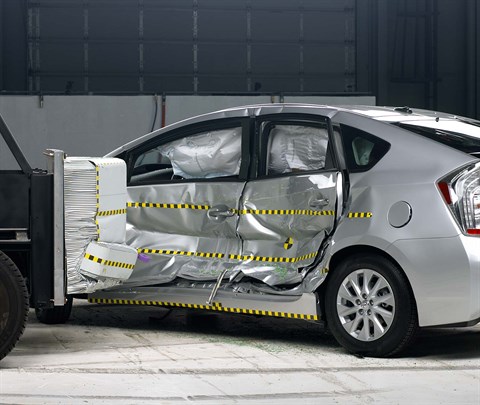
View of the vehicle and barrier just after the Institute's crash test.
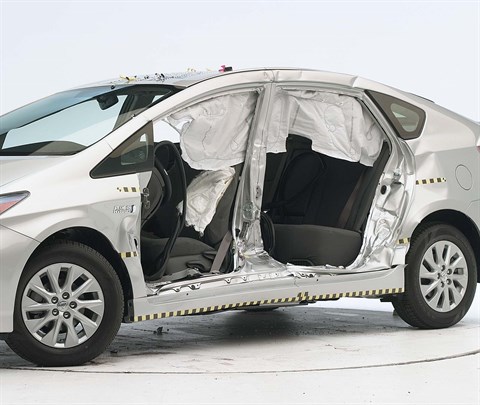
View of the vehicle after the crash with doors removed, showing the side airbags and damage to the occupant compartment.
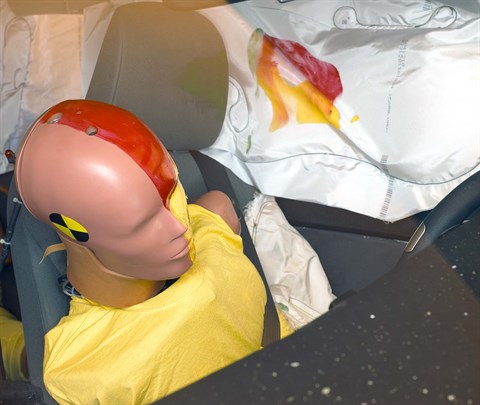
Smeared greasepaint shows where the driver dummy's head was protected from being hit by hard structures by the side curtain airbag in the Institute's test.
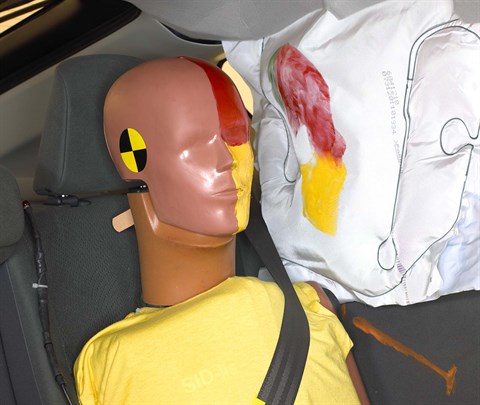
Smeared greasepaint shows where the rear passenger dummy’s head was protected by the side airbag.
Measures of occupant compartment intrusion on driver side
| Test ID | VTS0901 | CES1206 |
|---|---|---|
| B-pillar to longitudinal centerline of driver's seat (cm) | -11.0 | -11.5 |
| Negative numbers indicate the amount by which the crush stopped short of the seat centerline. | ||
Driver injury measures
| Test ID | VTS0901 | CES1206 |
|---|---|---|
| Head HIC-15 | 562 | 391 |
| Neck | ||
| Tension (kN) | 1.0 | 0.7 |
| Compression (kN) | 0.1 | 0.1 |
| Shoulder | ||
| Lateral deflection (mm) | 52 | 56 |
| Lateral force (kN) | 1.9 | 2.1 |
| Torso | ||
| Maximum deflection (mm) | 36 | 36 |
| Average deflection (mm) | 27 | 23 |
| Maximum deflection rate (m/s) | 5.50 | 3.11 |
| Maximum viscous criterion (m/s) | 0.78 | 0.51 |
| Pelvis | ||
| Iliac force (kN) | 1.0 | 1.5 |
| Acetabulum force (kN) | 1.9 | 1.8 |
| Combined force (kN) | 2.6 | 3.1 |
| Left femur | ||
| L-M force (kN) | 0.9 | 1.1 |
| L-M moment (Nm) | 191 | 180 |
| A-P moment (Nm) | -118 | 95 |
Passenger injury measures
| Test ID | VTS0901 | CES1206 |
|---|---|---|
| Head HIC-15 | 190 | 134 |
| Neck | ||
| Tension (kN) | 0.3 | 0.4 |
| Compression (kN) | 1.0 | 0.7 |
| Shoulder | ||
| Lateral deflection (mm) | 45 | 44 |
| Lateral force (kN) | 1.4 | 1.3 |
| Torso | ||
| Maximum deflection (mm) | 35 | 37 |
| Average deflection (mm) | 23 | 24 |
| Maximum deflection rate (m/s) | 4.50 | 4.44 |
| Maximum viscous criterion (m/s) | 0.69 | 0.82 |
| Pelvis | ||
| Iliac force (kN) | 0.7 | 0.8 |
| Acetabulum force (kN) | 2.2 | 1.9 |
| Combined force (kN) | 2.8 | 2.4 |
| Left femur | ||
| L-M force (kN) | 1.0 | 1.5 |
| L-M moment (Nm) | 230 | 231 |
| A-P moment (Nm) | 65 | -38 |
Roof strength
Rating applies to 2011-15 models built after December 2010
Tested vehicle: 2011 Toyota Prius Two 4-door
Rating applies to both the Prius (tested) and the Prius Plug-in Hybrid.
| Overall evaluation | |
|---|---|
| Curb weight | 3,056 lbs |
| Peak force | 12,846 lbs |
| Strength-to-weight ratio | 4.20 |
Head restraints & seats
Seat type: Manual cloth seats AHR
| Overall evaluation | |
|---|---|
| Dynamic rating | |
| Seat/head restraint geometry |
| Seat type | Manual cloth seats AHR |
|---|---|
| Geometry | |
| Backset (mm) | 37 |
| Distance below top of head (mm) | 34 |
| Seat design parameters | |
| Pass/fail | Pass |
| Max T1 acceleration (g) | 12.6 |
| Head contact time (ms) | 62 |
| Force rating | 1 |
| Neck forces | |
| Max neck shear force (N) | 1 |
| Max neck tension (N) | 499 |
How the head restraint & seat test is conducted
Currently, IIHS tests apply only to front seats.
